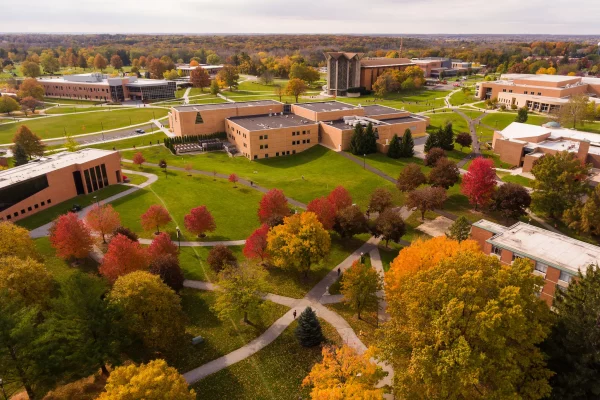Helping Create the Fuel of the Future

Valparaiso University’s James S. Markiewicz Solar Energy Research Facility (SERF) has been given a sub-award by the United States Department of Energy to join Arizona State University, the University of Michigan, and Sandia National Laboratories on an ambitious project that could change the way we fuel our world. The University will receive a total of $125,000 of the project’s grant funding, the majority of which will go towards retrofitting the SERF facilities to run the necessary tests and paying student researchers to be a part of the project.
The project centers around the use of perovskites, a classification of materials unique in the ways their composition can be altered to change their behaviors. Ultimately, the goal is to design altered perovskite structures that can easily and cheaply produce hydrogen and carbon monoxide by removing oxygen atoms from the molecules of water and carbon dioxide. Ideally, this new method of producing the molecules will prove key to creating affordable, liquid synthetic fuel.
“The Department of Energy has some ambitious cost targets,” says Peter Krenzke ’08, Ph.D., assistant professor of mechanical engineering at Valparaiso University. “This project is part of a push to reach one dollar per kilogram of clean hydrogen by 2031.”
At that cost, hydrogen-based fuel would be competitive with fossil fuels and battery power. The hydrogen produced by this process can also be used in creating the ammonia used in fertilizers.
Arizona State University is the project lead and will perform the computational chemistry and experimentation necessary to discover the perovskite composition needed to meet the project’s goals. Sandia National Laboratories and the University of Michigan will play important roles in materials testing and reactive element design.

With materials designed, researchers at Valparaiso University will be responsible for proving the merits of the system by demonstrating an early, but functional, prototype.
“We’ll do more than 100 cycles of this reduction and oxidation to show that the materials are stable over time,” Professor Krenzke says. “It’s no good to have a material that works for one cycle when you’re trying to run an industrial process.”
Proving the materials and process will be cost effective is not just a matter of stability, but quantity.
“Arizona State can make it work with a small amount of material, which is great and important, but we have to take it and make it work in a much larger quantity,” said Luke Venstrom ’07, Ph.D., associate professor of mechanical engineering.
Doing the necessary tests will require bringing in some new and more specialized technology. One item the SERF will be retrofitted with is a receiver reactor designed by Professor Krenzke when he was a graduate student. To test the material for stability, Professors Krenzke and Venstrom and their team will use a cutting-edge infrared imaging furnace to remove and reintroduce oxygen over 100 times.
“We’re tied to the weather with the solar furnace, and we don’t have as much time to run it during the semester,” Professor Venstrom says. “Having a small-scale setup like this that can just be turned on with electricity enables us to do experiments when we can’t run the furnace.”
While a large portion of Valpo’s funding from the grant will go towards upgrades and retrofitting, the remainder will go towards enhancing the student experience, supporting one of the primary pillars of Uplift Valpo: Our Beacon for the Journey Forward: creating exceptional learning opportunities.
“Students are going to be exposed to cutting-edge experiments that you won’t see anywhere else,” Professor Venstrom says. “Opportunities to work with this state-of-the-art equipment like the infrared imaging furnace are out there, but there aren’t many, the experience they’ll have looking at that is unique, and something they can talk about when they’re going on to graduate school or the industry.”

When Professors Krenzke and Venstrom graduated from Valparaiso University, they found that having their names as co-authors on publications in leading renewable energy journals was a major boost to applying to graduate school. Now, with this new project, they are able to give the same advantage to today’s students.
In addition to being a unique opportunity to engage in highly technical challenges, the students involved in this project will gain the kind of teamwork experience that’s vital to academic and industry projects.
“Our partner at Arizona State does the chemical engineering and materials science aspects, that expertise is something we don’t have to that degree. Our partner at Michigan is top-notch when it comes to doing the computational modeling,” Professor Krenzke says. “The opportunity for our students to see these different paths that they might take, that they can have a mechanical engineering degree and go on to do something different is one big benefit for them. Even just to see how this multidisciplinary team works together at this level on cutting-edge research, understanding that we all have our own limitations. Even if you’re the smartest person in the world, you still need these other team members to pull off something like we’re trying to do here.”
For more information on what’s happening at Valparaiso University’s College of Engineering, visit valpo.edu/engineering. For more on the exciting work happening at the SERF, read all about its history and goals at the Valpo Magazine article here.
